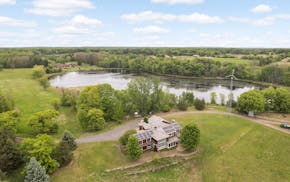Minnesota farmers are showing great interest in federal incentives to improve their conservation practices, but only a small minority have been successful in winning the grants.
That's not unique to Minnesota's farmers, according to a new study by the Institute for Agriculture and Trade Policy. It found that, between 2010 and 2020, successful applications from farmers around the country dropped significantly in two U.S. Department of Agriculture programs that help farmers pay for equipment and adopt practices that reduce greenhouse gas emissions and help them adapt to climate-related changes.
"It's going in the wrong direction in terms of making sure farmers have access to programs that incentivize the fight against climate change," said Michael Happ, who led the study.
The gap between applications and grantees is particularly stark in Minnesota. Last year, just 17% of Minnesota applicants to the Environmental Quality Assistance Program (EQIP) were awarded contracts, and only 14% had success applying to the Conservation Stewardship Program (CSP).
As the Biden administration and Congress hash out a federal spending package and Democrats push for big new investments in fighting and mitigating climate change, advocates for the two programs administered by the USDA's Natural Resource Conservation Service say that EQIP and CSP are a proven, successful way to enlist farmers directly in the battle.
"If we want to talk about how can farmers be part of the climate solution — well, literally they're asking to be, all we have to do is fund them," said Jessica Kochick, federal policy organizer at the Land Stewardship Project.
The Land Stewardship Project and the Institute for Agriculture and Trade Policy, both Minnesota-based nonprofits that promote sustainability in agriculture, are advocating at the federal level for a boost in spending on the two programs as Democrats shape their reconciliation package.
Kochick said many in agriculture's progressive movement prefer established programs that promote beneficial land management, as opposed to proposals for carbon markets in which companies looking to offset their own carbon emissions would pay farmers to adopt more environmentally friendly practices.
But some Democrats in Washington have been pushing carbon markets despite those concerns; on Thursday, the House Agriculture Committee held a hearing on the topic.
Ben Lilliston, the director of rural strategies and climate change at the Institute, tweeted during the hearing that he was more in agreement with Republicans on the panel — "that deeper investments in conservation programs is much better for farmers, that these markets pay farmers little and close out small-scale farmers," he wrote.
Advocates surmised that one of the reasons that rejections from the two programs were so high in Minnesota is that the state has been a leader in sustainable agriculture, and that many farmers who've received the incentives for some time were deemed no longer eligible.
Of the 1,541 Minnesota farmers who applied for CSP last year, 223 received contracts. Of 3,512 who applied for EQIP, 611 got contracts. With 50 states and two territories eligible, that left Minnesota 47th for CSP contracts and 50th for EQIP contracts.
Some other agricultural states had similarly low rates, but it wasn't universal. Out of 3,635 Wisconsin farmers who applied last year, 1,436 were awarded contracts, for instance.
The National Resource Conservation Service's press office did not respond to a request for comment on the report.
Congress reduced appropriations for the programs in the 2018 farm bill at the request of the Trump Administration, and Kochick said since then the incentives have been more likely to be granted to first-time applicants.
Hannah Bernhardt raises grass-fed beef, lambs and pastured pork near Pine City. At 39 she's five years into full-time farming after a move back to Minnesota from the East Coast. Last year, she got about $30,000 in EQIP funds that allowed her to install the permanent fencing and water lines needed for a system of rotational grazing that promotes soil health and cuts carbon release.
"It's allowed us to expand and grow our business," Bernhardt said, and to grow her cattle herd from 10 to 40. She said she felt doubly lucky when she learned how few Minnesota farmers qualified last year.
"They got it figured out, how to help farmers," Bernhardt said. "But if everyone can't access it, it's not doing what it could."

Minnesota Department of Health rescinds health worker layoffs

Eco-friendly house on 30 acres near Marine on St. Croix listed at $1.6M

DOGE cuts federal money for upgrades at Velveeta plant in New Ulm

